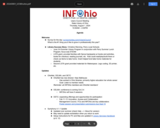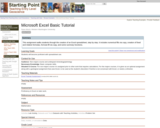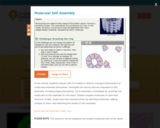
These are the meeting notes from the in-person Users Council meeting on August 1, 2024.
- Subject:
- 21st Century Skills
- Information, Media and Technological Literacy
- Material Type:
- Lecture Notes
- Date Added:
- 08/02/2024

These are the meeting notes from the in-person Users Council meeting on August 1, 2024.

These are the meeting notes from the virtual Users Council meeting on October 17, 2024.

The microscopic world is full of phenomena very different from what we see in everyday life. Some of those phenomena can only be explained using quantum mechanics. This activity introduces basic quantum mechanics concepts about electrons that are essential to understanding modern and future technology, especially nanotechnology. Start by exploring probability distribution, then discover the behavior of electrons with a series of simulations.

In this investigation, students will explore the question: Can there be life outside of Earth? Students will use planet hunting models to discover how scientists find new planets and perform simulated spectroscopic measurements to determine if the chemical requirements for life are present.

This NetLogo model of leaf photosynthesis shows the macroscopic outcome of the reaction.

Explore the history and geography of sub-Saharan Africa using lessons from an 8-Part lesson-set on Mali and Timbuktu which includes student and teacher versions as well as assessments.

In this activity the temperature of a reaction is monitored for different concentrations of reactants.

Repeated motion is present everywhere in nature. Learn how to 'make waves' with your own movements using a motion detector to plot your position as a function of time, and try to duplicate wave patterns presented in the activity. Investigate the concept of distance versus time graphs and see how your own movement can be represented on a graph.

In this activity, we will explore how the dosage and frequency of a medicine taken affect the amount of medicine present in the blood.

Meiosis is the process by which gametes (eggs and sperm) are made. Gametes have only one set of chromosomes. Therefore, meiosis involves a reduction in the amount of genetic material. Each gamete has only half the chromosomes of the original germ cell. Explore meiosis with a computer model of dragons. Run meiosis, inspect the chromosomes, then choose gametes to fertilize. Predict the results of the dragon offspring and try to make a dragon without legs. Learn why all siblings do not look alike.

Monitor the temperature of a melting ice cube and use temperature probes to electronically plot the data on graphs. Investigate what temperature the ice is as it melts in addition to monitoring the temperature of liquid the ice is submerged in.

A one page assignment that uses online tutorials to give students a first exposure to the components of a cell and membrane.

This assignment walks students through the creation of an Excel spreadsheet, step by step. It includes numerical fills via copy, creation of fixed and relative formulas, formula fill via copy, and some summary functions.

Learn to identify different molecular shapes, to understand the interactions that create these shapes, and how to predict a molecule's shape given certain information about it. Explore these concepts using three-dimensional computer models and answer a series of questions to reinforce your understanding.

In this activity, students interact with 12 models to observe emergent phenomena as molecules assemble themselves. Investigate the factors that are important to self-assembly, including shape and polarity. Try to assemble a monolayer by "pushing" the molecules to the substrate (it's not easy!). Rotate complex molecules to view their structure. Finally, create your own nanostructures by selecting molecules, adding charges to them, and observing the results of self-assembly.

Study the motion of a toy car on a ramp and use motion sensors to digitally graph the position data and then analyze it. Make predictions about what the graphs will look like, and consider what the corresponding velocity graphs would look like.

OETC 2024: Libraries Connect Ohio: Online Library Resources for all OhioansRoom C161AThursday, February 15, 20248:00 a.m. to 9:00 a.m.

OETC24: Ohio Education Job Board: Your PreK-12 Job Posting HubRoom C171Tuesday, February 131:00 p.m. to 2:00 p.m.

OETC 2024: Securing Your K12 EnvironmentTuesday, February 13, 20249:15 AM - 10:15 AMB240/241

OETC 2024: Workforce Ready: Resources to Support Employability SkillsRoom C171Tuesday, February 132:15 p.m. to 3:15 p.m